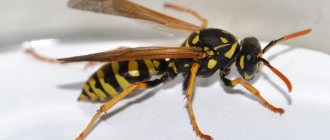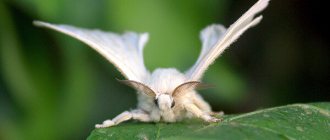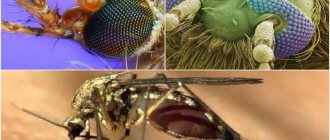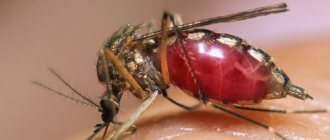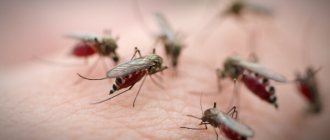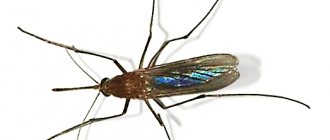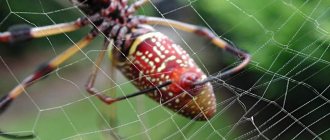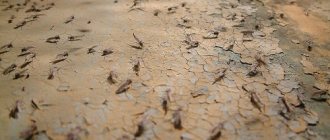Types of flower pests
When midges appear in indoor flowers, it is important to find out what type of pests threaten the health of your green pet. This knowledge will help you find the right method with which you can quickly and effectively deal with annoying insects.
The most famous insects to gardeners that settle in flower pots are 2 types:
- Sciarides. Small black or grayish midges, also called fungus gnats. They belong to the order Diptera. Their dimensions do not exceed two millimeters. They are easy to spot as they migrate from flower to flower, causing a lot of trouble in the house. The female insect lays eggs in moist soil; midges are especially attracted to those soils in which decomposition of organic matter occurs. The most susceptible plants to invasion by sciarids are violet, azalea, and various types of ficus.
- Springtails. A species of white wingless midges, also called springtails. They move around flowers by crawling, and adult insects make active jumps. Particularly dangerous are the larvae that eat the roots of plants. The period of active reproduction of springtails is winter and spring. These small white midges are partial to the delicate leaves of fuchsia and begonia. They also cause a lot of trouble for lovers of indoor orchids.
Flower midges are unlikely to harm human health, because they do not carry infections and do not sting. An exception may be overly impressionable people and small children, who may be frightened by the threatening activity of a horde of small insects.
Adult midges can cause irreparable damage to plants. By migrating between flowers, they can increase the risk of plant infection with a harmful fungus, as well as be carriers of the larvae of other harmful insects.
Why do flower midges appear?
Even the most careful and regular care cannot guarantee that the flowers in the house will not be attacked by pests. The occurrence of pests of flower plants in an apartment can be due to a number of the following easily explainable reasons:
- The soil remains too moist after watering. If moisture begins to stagnate in a flower pot, this becomes a favorable breeding ground for midge larvae in the ground.
- The larvae can get into the pot along with soil purchased at the market or in a store. This can be explained by the fact that the substrate was of poor quality or was not disinfected.
- Black sciarid midges often fly into the apartment from the street. Pots with flowers placed on the windowsill for ventilation, the soil in which is full of moisture, will be an excellent place for midges to lay eggs. For white midges, the place of entry into the room can be the ventilation openings of damp basements and cellars.
- Many gardeners themselves create a fertile environment for the reproduction of flower midges. If you water flowers with settled tea leaves or coffee solution, as well as other organic matter, which is strongly recommended to be used at home by “people’s advice,” you may run the risk of soon appearing in pots of both sciarids and stalks.
Chemical means of controlling midges
There is no shortage of chemicals to combat midges on the shelves of modern specialized stores. It is recommended to use them when less radical and safer methods for others have been tried or traces of severe infection are detected.
The most effective against flower midges are considered to be such drugs as Tanrek, Aktara, Fitoverm, Bazudin, Bona Forte. If it is possible to take the pot into a room where there are no people, food is not being prepared, etc., you can use Dichlorvos, Karbofos and their derivatives: Raid, Heo or Raptor, as well as Fufanon-Nova. Of the granular preparations, we can recommend Fly eater.
No matter how safe the drug may seem, you should always work with it wearing gloves, a gown and a mask (respirator)!
A single application may not completely solve the problem. The treatment should be repeated after a week or two. To clarify the period, it is recommended to determine the type of midges and learn about the development cycle of their larvae.
How to get rid of midges in indoor flowers
Start fighting the problem as soon as the place of their settlement has been discovered. If midges are infested in large numbers, and the flower soil is full of larvae, removing them will be a difficult task.
First of all, it is worth paying attention that you will have to process not only the flower where the midges were found. It is necessary to carefully inspect and treat all plants in the apartment, since larvae can be deposited in the ground of any of the flowers.
There are several products that can help fight pests of flower plants at home. The action of any of them can be individual for each flower.
Lovers of home flowers should carefully familiarize themselves with these products.
- Laundry soap solution. The product has been used for a very long time. To remove midges from a flower pot, you need to water it with a weak solution of laundry soap. At the same time, you need to make sure that the soil does not become too salty.
- Garlic. This product has been successfully used for decades. Take 2-3 garlic heads. The cloves are finely chopped or grated. Pour a liter of boiling water and leave for 4 hours. Part of the resulting solution is poured into a container with a spray bottle and used to spray flower plants. The other part of the solution must be watered onto the soil. Most often, a positive effect occurs after two or three procedures of using garlic.
- Tobacco infusion. 50 grams of finely chopped tobacco is poured with a liter of boiling water. Infuses for a couple of days. Then another liter of water is added to the resulting infusion. This solution can be applied to the flower using a sprayer or simply poured over the plant.
- Citrus peels. If there are midges in flower pots, orange or tangerine peels are a good way to get rid of them at home. They are evenly distributed around the perimeter of the flower pot, lightly buried in the ground.
- Potassium permanganate solution. This remedy is widely applicable not only to combat midges, but also to prevent diseases of flower plants.
- Matches. This folk remedy is one of the most accessible, but it will require patience. 4–5 matches are stuck into the ground with a sulfur head. The areas around the matches are slightly moistened. As soon as the sulfur is removed from the match heads, they are replaced with new ones. The procedure is repeated for a week.
- Citramon tablets. To get rid of midges, you can use this popular advice: dilute a citramon tablet in a three-liter jar of water. Water the flowers affected by the midge with the resulting solution.
- Duct tape. To get rid of midges, watering and spraying flower plants alone is not enough. To destroy females that lay eggs in the ground, sticky insect trap tapes are hung around the flowers.
- Dill. Another folk remedy based on the action of a persistent odor. Umbrellas or sprigs of dill are laid out on the surface of the soil. To rid the flower of midges, the dill in the pot must be changed once every 2 days.
Folk recipes for fighting fly
At first, you can try to get rid of midges in pots using traditional methods and start with the least traumatic ones for the plant.
First you need to let the soil dry at least two centimeters and slightly loosen its top layer. In such conditions, it is difficult for the larvae to survive, as they need a moist environment. Then catch all the flying insects. This is done using glue traps.
The simplest ones are a kind of flag made from a rectangle of thick paper on a toothpick. The paper is coated with chalk or molasses and stuck into the ground among the leaves. Traps are replaced as necessary. During this time, the plant should be watered very sparingly so that the top layer of soil does not get wet. The best way to do this is to place the pot in a large container of water. The window sill and the surface of the ground are treated with a vacuum cleaner without a brush. It easily attracts any flying insects.
After processing, the disposable bag should be thrown away, the regular bag should be emptied outside the apartment and disinfected with dichlorvos.
After destroying adult midges in indoor pots, you need to deal with the soil, in which a large number of larvae still remain. The dried and loosened soil is watered with a solution of one of the proven folk recipes:
- Garlic infusion. Chop one head of garlic and add 0.5 liters of water. The infusion is kept for several hours, then the ground is watered abundantly, the entire plant is sprayed, and the remaining garlic pulp is mixed with the top layer of soil.
- Potassium permanganate solution. Treat the plant with a weak pale pink solution once a week.
- Soap solution. Dissolve 20 g of laundry soap in one liter of warm water. The resulting soapy water is watered and sprayed on the diseased specimen weekly.
- Anti-worm medication for pets. It is diluted in a dosage suitable for treating cats and puppies and watered on the affected plant every week.
Folk remedies help with low levels of infection.
It is also convenient to remove midges from flowers in pots using a plastic bag large enough to fit the entire plant. It is important to position the bag so that not a single branch is crushed. Dichlorvos is sprayed under the bag and quickly tied with a rope in the middle of the pot. In such a greenhouse, all insects die within a few hours. It is necessary to remove the bag in another room where the flowers were not standing, and in the same place, treat with a vacuum cleaner and place glue traps. After two weeks, the plants treated with dichlorvos are returned to their place.
Chemicals for killing midges in flowers
If you can’t get rid of midges in flowers using folk remedies, you have to use chemicals.
To destroy midges using chemicals and not harm your health, it is recommended to follow safety measures and use personal protective equipment. After chemical treatment, the room must be ventilated.
Among the chemicals that can be used to treat midge-affected flowers, the most well-known are:
- "Aktara" - effectively fights black midges and their larvae, can be used for watering and spraying.
- “Regent” is a well-proven product, diluted in water for irrigation.
- “Kinmiks” is known for its powerful poisoning effect, but re-treatment with residual product is prohibited, and it cannot be stored.
- “Grom-2” is produced in the form of granules, which are scattered on top of the soil, preventing the appearance of midges in flower pots.
Some of the products cannot be used during flowering plants, which is why gardeners should carefully read the instructions for their use.
Where do midges in flower pots come from, how long do they live?
Many people grow flowers - this is an interesting and useful activity, both for the soul and for the home. Plants decorate the room and contribute to the production of oxygen necessary for adults and children. Any flowers are subject to the negative influences of the surrounding world: unfavorable conditions, insufficient or excessive care, animals (cats, for example, who dig the ground and gnaw leaves), insects.
Plants are often attacked by midges, and these insects are the cause of improper care by humans. Some who don’t like to tinker with flowers too much will simply throw out the pot, but “uninvited guests” can be easily removed if you know the methods and secret traps for such midges. Thus, the plant will remain completely unharmed.
In addition to midges, a plant can suffer from a host of diseases, and the appearance of midges is not the problem itself, but only its consequence. Insects appear in pots that are over-filled with water. Increased dampness and abundance of moisture attract midges. Damage to the plant can be caused by larvae laid by midges directly into the ground.
IMPORTANT: “You should sound the alarm when you notice at least one midge on the soil surface.”
What can cause midges to appear:
- You initially chose poor quality and poor soil for the flower. An open window often serves as a “bait” to lure midges into the room.
- You water the flowers too often and too much and the soil “rots,” which makes it attractive to midges.
You can fight such midges with any homemade or special means. There are several varieties of midges, which determines their lifespan. Some species live no more than 10-14 days, others up to 3 months. Life expectancy can also be affected by the time of year; in the heat, midges live shorter, but reproduce more often and more abundantly.
"House" midges in flowers and plants
Preventive measures to help get rid of midges in flowers
Every lover of indoor plants can provide decent care and comfortable conditions for the development of flowers. Preventive measures tell you what needs to be done to prevent midges from infesting flowers.
- When buying indoor flowers in a store, you need to pay special attention to the condition of the soil. It would also be useful to purchase a product for its insecticidal treatment.
- To avoid rotting of plant roots, you need to regularly loosen the soil in pots. This will ensure access to the oxygen the flowers need.
- Avoid watering indoor plants with liquids containing organic matter. It is better to use special fertilizers or flower food.
- Replant the flower in soil that does not contain rot, mold, or remains of rotting leaves.
- Also, when replanting, you should pay attention to the cleanliness of the pot (if it is old).
By following all these measures, you can ensure that flower gnats no longer appear.
Did you like the article? Was she helpful?

